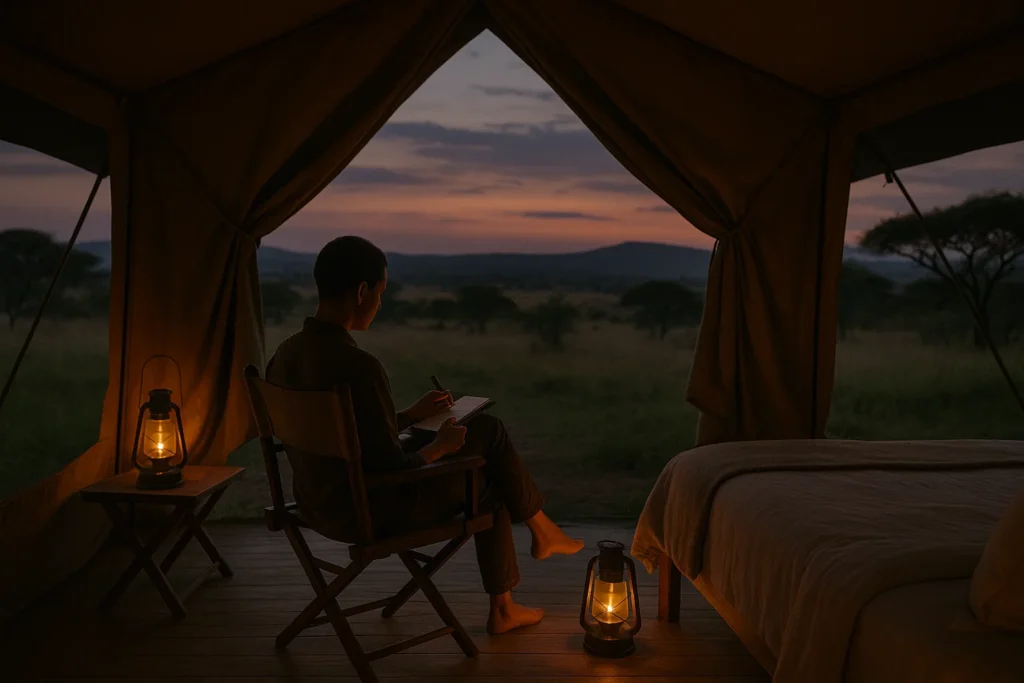Safari travel offers an opportunity to disconnect, reconnect with nature, and recharge. But for travelers managing anxiety, insomnia, depression, PTSD or other mental health conditions, a remote wilderness setting also adds extra layers of risk and challenge. With thoughtful preparation, you can minimize stress, maintain stability, and even use the journey as a healing experience. This guide walks you through what to plan for, how to self-manage emotionally, and what supports to put in place before and during a safari.
Why mental health deserves its own safari plan
Safaris tend to be remote—and that means:
- Delays in access to medical or psychological support services
- Unpredictable schedules, long drives, early wake-ups, limited downtime
- Environmental triggers (heat, noise, wildlife sounds, terrain)
- Disruptions to sleep, eating, routines
- Emotional impacts of isolation, novelty, and navigating uncertainty
At the same time, nature therapy and immersive wilderness can offer therapeutic benefits (reduced cortisol, mindfulness, emotional reset). Many safari lodges now recognize wellness as part of the guest experience. Your goal is to lean into those benefits while safeguarding stability.
Before you go: pre-trip preparation
1. Consult your mental health provider
- Discuss your intention to travel and confirm your medications and regimen are stable enough.
- Request a travel letter or summary with diagnosis, medications, dosages, and emergency plan.
- Talk through red flags to watch for and rehearse coping strategies.
2. Research mental health resources along your route
- Identify hospitals, clinics, counselors, or telehealth options in your safari region.
- Check if English-speaking professionals are available.
- Know local cultural attitudes toward mental health.
- Confirm insurance coverage for mental health emergencies or evacuation.
3. Build buffer and flexibility into your itinerary
- Avoid packed days; schedule rest time.
- Choose camps with quiet, restful environments.
- Stay longer in fewer locations to reduce transit stress.
- Consider wellness-oriented lodges that offer yoga, meditation, or spa options.
4. Pack a mental health kit
- Medications (in original, labeled packaging) + backup supply
- Crisis sheet with coping tools and contacts
- Journaling tools, mood trackers, grounding scripts
- Earplugs, sleep mask, comfort objects
- Portable charger and power bank
- Digital mental health documents (saved securely offline)
5. Practice routines & resilience tools
- Develop and rehearse breathing, mindfulness, or grounding techniques.
- Simulate light travel stress before departure.
- Start a habit of daily mental self-checks.
On safari: strategies for emotional self-management
1. Anchor routines where possible
- Maintain consistent sleep/wake times.
- Use small home rituals to ground yourself (e.g., tea, music, reading).
- Wind down each night with a calming practice.
2. Prioritize sleep hygiene
- Use earplugs, white noise, and eye masks.
- Avoid stimulants late in the day.
- Use sleep aids only as prescribed.
3. Manage anxiety in the field
- Use grounding: sensory techniques, breathing, visualizations.
- Keep your coping tools nearby.
- Create quiet spaces in camp to retreat to.
- Communicate discreetly with your guide about any specific needs.
4. Stay connected (on your terms)
- Schedule brief check-ins with a support person.
- Use mood journals to release emotions.
- Plan minimal communication strategies with loved ones for peace of mind.
5. Embrace nature for healing
- Slow down to absorb the sensory richness of nature.
- Use walking safaris or guided nature walks to reset.
- Anchor attention in sight, sound, texture—helping calm racing thoughts.
6. Monitor red flags
- Know your early signs of deterioration.
- Use your emergency contacts or telehealth options early.
- Don’t wait for crisis to act.
After safari: reintegration & reflection
- Allow a decompression buffer before returning to routine.
- Reflect via journaling or therapy.
- Identify habits or insights to bring into daily life.
- Monitor for post-trip anxiety, isolation, or dysregulation.
FAQs
Yes, with stable conditions and good preparation. Many travelers manage this successfully.
Bring the full dosage plus 10–20% extra. Always pack it in your carry-on with labels and documentation.
Only if you’re comfortable. A brief note can help them support you discreetly if needed.
Set up telehealth backup plans and carry written summaries of your history and emergency strategies.
Yes. Studies show reduced cortisol and improved mood from immersive nature exposure.
Rely on your sleep tools: mask, earplugs, grounding scripts. Rebuild your rhythm slowly.






